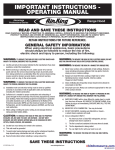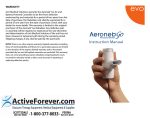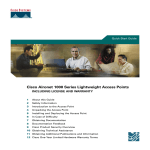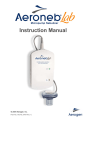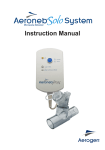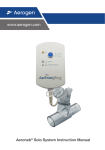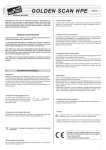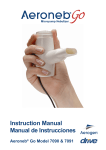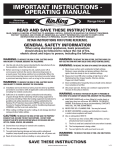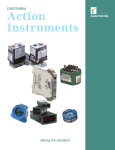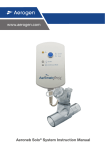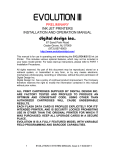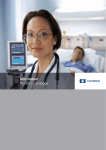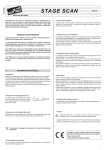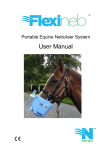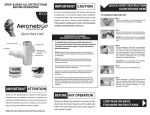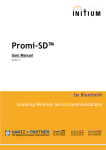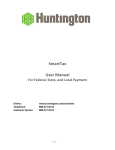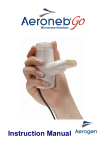Download AeroNeb Pro Instruction Manual
Transcript
Instruction Manual . ® Aeroneb Professional Nebulizer System Instruction Manual This page has been intentionally left blank . Table of contents Introduction.............................................................................. 1 System description ............................................................. 2 Warnings ............................................................................ 4 Warnings ............................................................................ 5 Electromagnetic susceptibility ............................................ 6 Warnings ............................................................................ 7 Symbols ............................................................................. 8 Warranty........................................................................... 12 Life of Product .................................................................. 12 Assembly and Installation ..................................................... 13 Recharging the Battery .................................................... 15 Installation for use with a ventilator .................................. 16 Installation for use with a mask ........................................ 20 Installation for use with a mouthpiece .............................. 22 Adding medication ........................................................... 23 Nebulization .......................................................................... 25 Functional test ....................................................................... 27 Cleaning, disinfection and sterilization .................................. 28 Troubleshooting .................................................................... 34 Order numbers ...................................................................... 37 Specifications ........................................................................ 39 Physical ............................................................................ 39 Environmental .................................................................. 39 Performance .................................................................... 40 Appendix 1 EMC Tables ....................................................... 43 Aeroneb® Professional Nebulizer System Instruction Manual i List of Figures Figure 1: Aeroneb Pro ............................................................. 2 Figure 2: Aeroneb Pro controls and indicators...................... 10 Figure 3: Connecting nebulizer unit to T-piece ..................... 13 Figure 4: Connecting control module and nebulizer unit ...... 14 Figure 5: Connecting the AC/DC adapter ............................. 15 Figure 6: Connecting to an adult breathing circuit ................ 17 Figure 7: Connecting to a pediatric breathing circuit ............ 17 Figure 8: Connecting to a neonatal breathing circuit ............ 17 Figure 9: Alternative neonatal breathing circuit using neonate T-piece ........................................... 18 Figure 10: Control module and universal mounting bracket (vertical) ................................................................ 18 Figure 11: Control module and universal mounting bracket (horizontal) ........................................................... 19 Figure 12: Equipment mount adapter ................................... 19 Figure 13: Connecting to a mask .......................................... 21 Figure 14: Connecting to a mouthpiece ................................ 22 Figure 15: Filling the nebulizer unit with a pre-filled ampoule .............................................. 23 Figure 16: Maximum fill indication point ................................ 24 Figure 17: Starting and stopping nebulization....................... 26 List of Tables Table 1: Aeroneb Pro symbols ................................................ 8 Table 2: Aeroneb Pro controls and indicators ....................... 11 Table 3: Aeroneb Pro troubleshooting .................................. 34 Table 4: Aeroneb Pro parts list ............................................. 37 ii Aeroneb® Professional Nebulizer System Instruction Manual Introduction ® The Aeroneb Professional Nebulizer System is a portable medical device for multiple patient use that is intended to aerosolize physician-prescribed medications for inhalation that are approved for use with a general purpose nebulizer. This device can be used by patients on and off mechanical ventilation or other positive pressure breathing assistance. ® Aeroneb Pro is suitable for use by neonate, pediatric to adult patients as described in this manual. It incorporates the ® TM Aerogen OnQ Aerosol Generator. ® Aeroneb Pro is intended for hospital use only. It is designed to operate in-line with standard ventilator circuits and mechanical ventilators. It operates without changing patient ventilator parameters and can be refilled without interrupting ventilation. The control module operates from the AC/DC adapter and can be operated on its internal rechargeable battery for up to 45 minutes when fully charged. The product operates without compressed gas, making it suitable for portable applications. Indications for Use: ® The Aeroneb Professional Nebulizer System is a portable medical device for multiple patient use that is intended to aerosolize physician-prescribed solutions for inhalation to patients on and off ventilation or other positive pressure ® breathing assistance. The Aeroneb Professional Nebulizer System is suitable for use in adult, pediatric and neonate patients. Aeroneb® Professional Nebulizer System Instruction Manual 1 System description The Aeroneb Professional Nebulizer System (Figure 1) includes the following components: nebulizer unit (Aerosol Generator and filler cap), T-piece (adult) with plug, control module, control module cable, AC/DC adapter, and mounting brackets. T-piece plug Filler Cap 1. Nebulizer unit with filler cap 2. T-piece (adult) with plug 3. Control module 4. Control Module Cable 5. AC/DC adapter 6. Universal mounting bracket 7. Equipment mount adapter Figure 1: Aeroneb Pro 2 Aeroneb® Professional Nebulizer System Instruction Manual 1. The nebulizer unit holds up to 10 mL of liquid medication. The nebulizer unit is translucent to allow visual monitoring of medication levels and aerosolization. When the nebulizer unit is connected into the breathing circuit, the filler cap can be opened or removed from the nebulizer unit without causing loss of circuit pressure. TM Within the nebulizer unit is an OnQ Aerosol Generator, which consists of a domed aperture plate with precision-formed holes that control the size of the aerosol droplets and a vibrational element that creates micro-pumping action to aerosolize medication. Gravity brings the medication in contact with the aerosol generator; the liquid is then drawn through the aperture plate and converted into an aerosol. 2. The T-piece securely connects the nebulizer unit into the breathing circuit and can be easily removed for cleaning. The T-piece connections are standard male and female 22 mm ISO conical ports and connect to standard patient breathing circuits. 3,4,5. The control module can operate from the AC/DC adapter or the internal rechargeable battery. The control module includes an On/Off power button and sockets for the control module cable and the AC/DC adapter. The control module also includes indicators for nebulization cycle selection (15 or 30 minutes), battery charge status and fault conditions. 6. A universal mounting bracket clamps the control module to standard IV poles and medical rail systems. 7. An equipment mount adapter mounts the control module on standard equipment mounts. Pediatric T-piece, neonate adapters, mask adapter kits, elbow connectors and mouthpiece are sold separately. Aeroneb® Professional Nebulizer System Instruction Manual 3 Warnings Read and study all instructions before using Aeroneb Pro. Only medical personnel should operate the device. During use observe for correct functioning of the nebulizer by regularly verifying aerosol is visible and no flashing indicator lights. Do not use a filter or heat-moisture exchanger (HME) between the nebulizer and patient airway. Do not attach a continuous supply of medication to the nebulizer; the device operates in 15 or 30 minute cycles. Clean, sterilize, assemble and perform a functional test (page 27) according to the instructions in this manual before first use and between patients. Do not place the control module in an incubator during use. To avoid exhaled medication affecting the ventilator, follow ventilator manufacturer’s recommendations for use of a bacterial filter in the expiratory limb of a breathing circuit. To ensure optimum drug administration, consult the drug manufacturer’s instructions regarding suitability for nebulization. Do not use in the presence of a flammable anesthetic mixture combined with air or with oxygen or nitrous oxide. Do not use to aerosolize alcohol-based medications, which can ignite in oxygen-enriched air under high pressure. To avoid the risk of fire, do not use in the presence of flammable substances. Do not modify this equipment without the authorization of the manufacturer. 4 Aeroneb® Professional Nebulizer System Instruction Manual Warnings To avoid damage to the nebulizer: Prior to use, autoclave according to specified directions and temperature given in the Cleaning, disinfection and sterilization section of this Instruction Manual only. Any deviation from directions given in this Instruction Manual may cause damage to the nebulizer unit and render it inoperable. Do not apply undue pressure to the domed aperture plate in the center of the nebulizer. Do not push out the OnQ Do not use a syringe with a needle to add medication. Do not use abrasive or sharp tools to clean the nebulizer unit. TM Aerosol Generator. Inspect all parts before use, and do not use if any parts are missing, cracked or damaged. In case of missing parts, malfunction or damage, contact your Aeroneb Pro nebulizer system sales representative. Disconnect nebulizer unit from control module before cleaning. Do not immerse or autoclave the control module or AC/DC adapter. Disassemble all parts before autoclaving. Use only with components specified by Aerogen. Do not use or store outside of specified environmental conditions. To avoid mechanical or electrical damage, do not drop the nebulizer unit or the control module. Aeroneb® Professional Nebulizer System Instruction Manual 5 Do not use in the presence of devices generating high electromagnetic fields such as magnetic resonance imaging (MRI) equipment. The Aeroneb Pro control module contains a nickel metal hydride (NiMH) rechargeable battery, which should be disposed of in accordance with local governing restrictions at the end of its useful life. Electromagnetic susceptibility This device meets the requirements of the Electromagnetic Compatibility (EMC), pursuant to the Collateral Standard, IEC/EN 60601-1-2 which addresses EMC in North America, Europe and other global communities. This includes immunity to radio frequency electric fields and electrostatic discharge, in addition to the other applicable requirements of the standard. Compliance with EMC standards does not mean a device has total immunity; certain devices (cellular phones, pagers, etc.) can interrupt operation if they are used near medical equipment. Follow institutional protocol regarding the use and location of devices that could interfere with medical equipment operation. Note: This device is classified as Class II Type BF medical electrical equipment and the device complies with specified safety levels for electrical isolation and leakage current. The Aeroneb Pro AC/DC adapter has no connection to earth ground because the necessary level of protection is achieved through the use of double insulation. 6 Aeroneb® Professional Nebulizer System Instruction Manual Warnings Only use the Aeroneb Pro nebulizer with components specified in the Instructions for Use. Use of the Aeroneb Pro nebulizer with components other than those specified in the Instructions for Use may result in increased emissions or decreased immunity of the Aeroneb Pro nebulizer system. Do not use the Aeroneb Pro adjacent to or stacked with other equipment. If adjacent or stacked use is necessary, the device should be observed to verify normal operation in this configuration. The Aeroneb Pro needs special precautions regarding electromagnetic compatibility (“EMC”) and must be installed and put into service according to the EMC information provided in the Instructions for Use. Portable and mobile radio frequency (“RF”) communication devices can disrupt medical electrical equipment. Refer to appendix 1 for EMC tables as per IEC / EN 60601-1-2 Aeroneb® Professional Nebulizer System Instruction Manual 7 Symbols The following symbols apply to Aeroneb Pro and appear on the back of the control module and on the packaging: Table 1: Aeroneb Pro symbols Symbol AP-YYXXXX Meaning Serial number, where YY is the year of manufacture and XXXX is the serial number. Attention, consult accompanying documents. Degree of protection against dripping water. Class II equipment per IEC/EN 60601-1. Type BF equipment per IEC/EN 60601-1. On/Off power button (standby). Timer selection (to select the 15 minute or 30 minute nebulization cycles). Control Module Input – DC voltage. ~ Control Module Output – AC voltage. Output. 8 Aeroneb® Professional Nebulizer System Instruction Manual Table 1: Aeroneb Pro symbols Symbol Meaning Does not contain natural rubber latex. Battery status indicator. Fragile, handle with care. +60C -20C Transient storage temperature limitations –20 C to +60 C. Keep dry. This device complies with the requirements of the Medical Devices Directive (93/42/EEC). Consult Instructions for Use. Manufacturer. Refer to instruction manual/booklet. Classified by TUV with respect to electric shock, fire and mechanical hazards. Aeroneb® Professional Nebulizer System Instruction Manual 9 Controls and indicators On/Off Power Fault Indicator Timer Selection 30 Min. Indicator Battery Status Indicator 15 Min. Indicator 9V D.C. Input Control Module Cable Input Figure 2: Aeroneb Pro controls and indicators 10 Aeroneb® Professional Nebulizer System Instruction Manual Table 2: Aeroneb Pro controls and indicators Control/indicator Function 15 Min. indicator Green (steadily lit) = 15 minute nebulization cycle on Green (flashing) = Low battery power Nebulizer unit automatically powers off after 15 minutes have elapsed 30 Min. indicator Green (steadily lit) = 30 minute nebulization cycle on Green (flashing) = Low battery power Nebulizer unit automatically powers off after 30 minutes have elapsed Fault indicator Amber = Faulty electrical connection On/Off power button Pressing and immediately releasing selects the 15 minute nebulization cycle Pressing and holding for at least three seconds selects the 30 minute nebulization cycle Pressing during nebulization turns off power to the nebulizer Battery status indicator Green = Battery fully charged Amber = Battery charging No light = Battery in operation Aeroneb® Professional Nebulizer System Instruction Manual 11 Warranty The Aeroneb Pro nebulizer unit is warranted for one year from date of purchase against defects in manufacturing. The Aeroneb Pro Control Module and AC/DC Adapter are warranted for a period of two years from the date of purchase against defects in manufacturing. All warranties are based on typical usage. Life of Product As with all active electronic components, the Aeroneb Pro nebulizer unit has a defined life. In the case of the Aeroneb Pro Controller, the life of the controller unit has been validated for use for 1460 doses. This is based on a typical product usage profile over a two year period, including four treatments per day, 50% of the time. The life of the Aeroneb Pro nebulizer and components have been validated for use for 730 doses and 26 autoclave treatments based on a typical one year usage profile of four treatments per day and one sterilization per week, where the device is assumed to be in service for 50% of the time. The user should note that any use in excess of this may result in reduced life of the product. 12 Aeroneb® Professional Nebulizer System Instruction Manual Assembly and Installation 1. Clean and sterilize the nebulizer unit and T-piece(s) as described in the Cleaning, disinfection and sterilization section of this manual. Note: The nebulizer unit and T-piece, as packaged, are not sterile. 2. Perform a functional test of Aeroneb Pro before use and between patients as described in the functional test section of this manual. 3. Insert the filler cap into the opening on the nebulizer unit. 4. Connect the nebulizer unit to the T-piece by pushing the nebulizer unit firmly onto the T-piece (Figure 3). Figure 3: Connecting nebulizer unit to T-piece Aeroneb® Professional Nebulizer System Instruction Manual 13 5. Connect the control module and the nebulizer unit together using the control module cable (Figure 4). Fig 3 Figure 4: Connecting control module and nebulizer unit 6. To operate on AC power (the primary mode of operation), insert the AC/DC adapter connector into the control module and plug the adapter into an AC power source (Figure 5). 7. Aeroneb Pro can be battery-operated for portable applications. The rechargeable battery can power the System for up to 45 minutes when fully charged. In the case of AC power failure the control module will automatically switch to battery operation. Note: Allow a minimum of four hours for the internal battery to fully recharge. Note: To ensure uninterrupted operation of Aeroneb Pro, secure both the AC/DC adapter cable and the control module cable so they cannot become disconnected during treatment. If clips are available on patient circuits, run the cables through the eyes of the clips. If clips are not available, ensure that all cables are routed safely. 14 Aeroneb® Professional Nebulizer System Instruction Manual Figure 5: Connecting the AC/DC adapter Recharging the Battery To recharge the battery, connect the AC/DC adapter to the control module and AC power (Figure 5). The battery status indicator is amber while charging and green when fully charged. Allow a minimum of four hours for the internal battery to fully recharge. Note: If the control module is placed in long-term storage, it is recommended that the battery be recharged every 3 months. Aeroneb® Professional Nebulizer System Instruction Manual 15 Installation for use with a ventilator 1. For adult breathing circuits, connect the nebulizer unit with adult T-piece into the inspiratory limb of the breathing circuit before the patient Y (Figure 6). For pediatric breathing circuits, connect the nebulizer unit with pediatric T-piece into the inspiratory limb of the breathing circuit before the patient Y (Figure 7). For neonatal breathing circuits, connect the nebulizer unit with the pediatric T-piece and the neonate adapters approximately 30 cm (12 in.) back from the patient Y (Figure 8). Alternatively connect the nebulizer with the Neonate T-piece 30 cm (12 in.) back from the patient Y (Figure 9). WARNING: Always maintain the nebulizer in a vertical orientation (with the filler cap uppermost) while in the patient circuit (Figures 6, 7, 8 and 9). This orientation prevents condensate from blocking the nebulizer and ensures proper nebulization. Always visually inspect the nebulizer prior to placing in the ventilator circuit to assure that no TM secretions are blocking the OnQ Aerosol Generator. When removing the nebulizer unit from the patient circuit always replace the T-piece plug to maintain circuit pressure. Condensate can collect and occlude ventilator circuits. Always position ventilator circuits so that fluid condensate drains away from the patient. Always connect a bacteria filter to the expiratory inlet of the ventilator. Otherwise the function of the expiratory channel may be degraded. 16 Aeroneb® Professional Nebulizer System Instruction Manual Y ADULT From ventilator Adult T-piece Figure 6: Connecting to an adult breathing circuit Y PEDIATRIC From ventilator Pediatric T-piece Figure 7: Connecting to a pediatric breathing circuit Neonate adapters NEONATE Y From ventilator Pediatric T-piece Figure 8: Connecting to a neonatal breathing circuit Aeroneb® Professional Nebulizer System Instruction Manual 17 From ventilator Y Neonate T-Piece Figure 9: Alternative neonatal breathing circuit using neonate T-piece 2. Always perform a leak test of the breathing circuit after inserting or removing the nebulizer unit. Follow ventilator manufacturer instructions for performing a leak test. 3. Use the universal mounting bracket to attach the control module to an IV pole or bed rail in either a vertical or horizontal orientation (Figure 10 and Figure 11). Do not over-tighten knob. Where a standard equipment mount is available, use the equipment mount adapter to support the control module (Figure 12). Figure 10: Control module and universal mounting bracket (vertical) 18 Aeroneb® Professional Nebulizer System Instruction Manual Figure 11: Control module and universal mounting bracket (horizontal) Standard equipment mount Figure 12: Equipment mount adapter Aeroneb® Professional Nebulizer System Instruction Manual 19 Installation for use with a mask Mask kits, which include a vented elbow and mask elbow, are available separately (see Order numbers section). Contact your Aeroneb Pro nebulizer system sales representative for ordering information. 1. When using a mask, connect the vented elbow, mask elbow and mask to the nebulizer unit by firmly pushing the parts together. 2. Rotate the vented elbow to suit the position of the patient (Figure 13). CAUTION: To ensure proper nebulization, maintain the nebulizer in a vertical orientation (Figure 13). 20 Aeroneb® Professional Nebulizer System Instruction Manual Vented Elbow Facemask Elbow Patient Upright Patient Reclined Figure 13: Connecting to a mask Aeroneb® Professional Nebulizer System Instruction Manual 21 Installation for use with a mouthpiece Aeroneb Pro works with any standard ISO 22 mm nebulizer mouthpiece inserted into the adult T-piece. When using a mouthpiece, connect the nebulizer unit to the T-piece as shown in Figure 3 in this manual, and then connect the T-piece to the mouthpiece by pushing the parts firmly together (Figure 14). Figure 14: Connecting to a mouthpiece CAUTION: To ensure proper nebulization, maintain the nebulizer in a vertical orientation (Figure 14). 22 Aeroneb® Professional Nebulizer System Instruction Manual Adding medication 1. Open the filler cap tab on the nebulizer unit. 2. Use a pre-filled ampoule or syringe to add medication into the filler port of the nebulizer (Figure 15). 3. Close the filler cap tab. CAUTION: To avoid damage to the nebulizer unit, do not use a syringe with needle. The maximum capacity of the nebulizer unit is 10 mL. Do not fill the nebulizer unit beyond the maximum fill indication point (Figure 16). The underside of the filler cap represents maximum fill indication point. Figure 15: Filling the nebulizer unit with a pre-filled ampoule Note: Medication can also be added in this manner during nebulization. This does not interrupt nebulization or ventilation. Aeroneb® Professional Nebulizer System Instruction Manual 23 Max. fill indication point Figure 16: Maximum fill indication point 24 Aeroneb® Professional Nebulizer System Instruction Manual Nebulization For doses less than or equal to 3 mL. 1. To start a 15 minute nebulization cycle, add the medication and press and release the blue On/Off power button (Figure 17). The green 15 Min. indicator lights to indicate that the 15 minute nebulization cycle is in progress. For doses greater than 3 mL. 2. To start a 30 minute nebulization cycle, add the medication and press and hold the blue On/Off power button for at least three seconds. The green 30 Min. indicator lights to indicate that the 30 minute nebulization cycle is in progress. 3. To stop the nebulizer at any time, press the On/Off power button. The indicator turns off to indicate that nebulization has stopped. Note: When delivering a dose greater than 3 mL, select the 30 minute cycle. Aeroneb® Professional Nebulizer System Instruction Manual 25 30 Min. Indicator On/Off Power Button Press and release to select 15 min Press and hold for three seconds to select 30 min. 15 Min. Indicator Figure 17: Starting and stopping nebulization 26 Aeroneb® Professional Nebulizer System Instruction Manual Functional test Perform a functional test of Aeroneb Pro prior to first use, after each sterilization before each patient use or at any time to verify proper operation. Follow these steps: 1. Visually inspect each part of the System for cracks or damage and replace if any defects are visible. 2. Pour 1-5 mL of normal saline (0.9%) into the nebulizer unit. 3. Connect the nebulizer unit to the control module using the control module cable. Connect the control module to the AC/DC adapter and plug the AC/DC adapter into an AC power source. 4. Press and release the blue On/Off power button and verify that the green 15 Min. indicator lights and that aerosol is visible. 5. Press the On/Off power button again to turn the System off. Press and hold the button for at least three seconds. Verify that the green 30 Min. indicator lights and that aerosol is visible. 6. Disconnect the control module from the AC/DC adapter and verify that nebulization continues and that the battery status indicator turns off. 7. Turn the System off and verify that the 15 Min. and 30 Min. indicators are off. 8. Discard any remaining liquid before patient use. Aeroneb® Professional Nebulizer System Instruction Manual 27 Cleaning, disinfection and sterilization This section describes how to clean, disinfect, sterilize and inspect Aeroneb Pro system components. It is important that Aeroneb Pro device components are cleaned and sterilized prior to first patient use. The components are: Nebulizer unit (including filler cap) T-piece (including T-piece plug) for adult and pediatric Neonate adapters Control module†, control module cable†, and AC/DC adapter† Mounting bracket† † Components not to be autoclaved. CAUTION: Always clean, sterilize and disinfect in accordance with current hospital protocols. To avoid damage to the nebulizer: 28 Autoclave according to specified directions and temperature given in the “Cleaning, disinfection and sterilization” section of this Instruction Manual only. Any deviation from directions given in this Instruction Manual may cause damage to the nebulizer unit and render it inoperable. Do not apply undue pressure to the domed aperture plate in the center of the nebulizer. Do not push out the OnQ TM Aerosol Generator Aeroneb® Professional Nebulizer System Instruction Manual Manual Cleaning Cleaning nebulizer unit, T-pieces and neonate adapters 1. Ensure there is no medication remaining in the device. 2. Remove nebulizer unit from T-piece. Remove filler cap from nebulizer unit. 3. Clean all parts with warm water and mild liquid detergent in accordance with current hospital protocols. 4. Rinse parts with sterile water. 5. Shake excess water from parts and allow parts to fully air dry. CAUTION: Do not use abrasive or sharp tools to clean the nebulizer unit. Automated Washing Cycle The Aeroneb Pro Nebulizer System has been validated with the following automated washing cycles. Automated Cycle One: Detergent: Liquid alkaline cleaner (diluted as per manufacturers instruction) Water Quality: Mains water Method: 1. Load the components in the automated washer. 2. Pre-rinse the components for 3 minutes. 3. Clean the components with liquid alkaline cleaner at 55°C (131°F) for 10 minutes. 4. Rinse for 1 minute. 5. Rinse using thermal disinfection cycle at 93°C (199.4°F) for 10 minutes. Aeroneb® Professional Nebulizer System Instruction Manual 29 Automated Cycle Two: Detergent: The following cycle was validated without the use of a detergent Water Quality: Mains water Method: 1. Load the components in the automated washer. 2. Wash components for 10 minutes at 91°C (195.8°F). 3. Drain the machine for 40 seconds. 4. Rinse at 90°C (194°F) for 1 minute. 5. Drain the machine for 40 seconds. 6. Rinse at 90°C (194°F) for 1 minute. 7. Drain the machine for 40 seconds. 8. Dry at 90°C (194°F) for 15 minutes. Disinfection of nebulizer unit, T-pieces and neonate adapters 1. Follow steps 1 through 3 in manual cleaning section on page 29. 2. Completely immerse parts in appropriate disinfecting agent in accordance with current hospital protocols and disinfectant agent manufacturer guidelines. NOTE: Aerogen approves the following disinfection solutions for use with its Aeroneb Pro Nebulization System regarding material compatibility. With respect to microbiological effectiveness, please ask the manufacturer. Refer to the product labeling for specific instructions regarding activation, safe use and disposal of these solutions. Isopropyl (70%) ® CIDEX ® NU-CIDEX ® CIDEX OPA Hexanios G+R 30 Aeroneb® Professional Nebulizer System Instruction Manual Sterilization of nebulizer unit, T-pieces and neonate adapters 1. Disconnect the nebulizer unit from the control module, and then remove the nebulizer unit and adapters from the ventilator circuit, mask or mouthpiece. 2. Disassemble the nebulizer unit and adapters into individual components. 3. Remove the filler cap from the nebulizer unit 4. Clean all parts with warm water and mild liquid detergent in accordance with current hospital protocols. Rinse thoroughly and air dry. 5. Check for cracks or damage and replace if any defects are visible. 6. Place the disassembled components into appropriate sterilization wrapping. CAUTION: Do not reassemble parts prior to autoclaving. Sterilize components: a. Steam sterilization can be performed using the following three methods: (i) autoclave wrapped parts using steam sterilization pre-vacuum cycle, a minimum of 134C (270°F - 275°F) for 3.5 minutes with drying cycle (134C wrapped cycle). (ii) autoclave wrapped parts using steam sterilization pre-vacuum cycle, a minimum of 121C (250°F) for 20 minutes with drying cycle (121C wrapped cycle). (iii) autoclave wrapped parts using steam sterilization pre-vacuum cycle, a minimum of 134C (270°F - 275°F) for 20 minutes with drying cycle (sometimes referred to as a “Prion cycle”). Aeroneb® Professional Nebulizer System Instruction Manual 31 NOTE: Sterilization using the long autoclave cycle ((iii) above) may cause some areas of the nebulizer to become discolored. This is not indicative of the performance of the nebulizer unit. b. To sterilize with hydrogen peroxide gas plasma, ® place wrapped parts in a STERRAD System, and use the long cycle. CAUTION: Users should refer to the product labelling for the ® STERRAD 100S Sterilization System for specific instructions regarding its proper operation. Prior to next use: (i) Check for cracks or damage and replace if any defects are visible. (ii) Perform a functional test as described in this manual. Cleaning of mounting brackets Wipe clean with a damp cloth and mild liquid detergent. Do not use abrasive or sharp tools. 32 Aeroneb® Professional Nebulizer System Instruction Manual Cleaning of control module, control module cable and AC/DC adapter 1. Wipe clean with an alcohol based disinfectant wipe or a quaternary ammonium compound based disinfectant wipe. 2. Check for exposed wiring, damaged connectors, or other defects and replace if any are visible. 3. Visually inspect for damage and replace the control module if any damage is observed. CAUTIONS: Do not autoclave. Do not use abrasive or sharp tools. Do not spray liquid directly onto the control module. Do not immerse control module in liquid. Caution: The Aeroneb Pro nebulizer unit contains active electronic components. Aerogen has validated the methods of cleaning, disinfection and sterilization above. The use of any other means of cleaning, disinfection or sterilization has not been validated and is likely to reduce the life of your nebulizer and will invalidate your warranty. Aeroneb® Professional Nebulizer System Instruction Manual 33 Troubleshooting If these suggestions do not correct the problem, discontinue use of any device that appears to be damaged or is not operating properly and contact your local Aeroneb Pro nebulizer system sales representative. Table 3: Aeroneb Pro troubleshooting If this happens: It could mean: Try this: The 15 Min. or 30 Min. indicator flashes during nebulization. Battery power is low. Recharge battery (see Recharging the battery). Battery will not recharge. Constant green light showing on the battery status indicator and flashing green light on either the 15 Min. or 30 Min. indicator light, when the control module is connected to the AC/DC adapter. It may be time to replace the battery. Contact your local Aeroneb Pro nebulizer system sales representative. Battery will not retain initial charge. Rechargeable battery may need to be replaced. Contact your local Aeroneb Pro sales representative. 34 Aeroneb® Professional Nebulizer System Instruction Manual Table 3: Aeroneb Pro troubleshooting If this happens: It could mean: Try this: The 15 Min. or 30 Min. indicator lights, but aerosol is not visible. No medication in nebulizer unit. Refill medication through filler cap in the nebulizer unit (see Adding medication during nebulization). Nebulizer unit has not been properly cleaned. Clean nebulizer unit (see Cleaning and sterilization). It may be time to replace the nebulizer unit. See Warranty and Life of Product. Refer to Aeroneb Pro parts list. 15 Min. or 30 Min. indicator does not light when On/Off power button is pressed. There is no power to the System. Verify that AC/DC adapter is securely attached to control module. Rechargeable battery is depleted. Recharge battery (see Recharging the battery). The fault indicator lights. The control module cable is incorrectly connected, or electronics are malfunctioning. Verify that control module cable is correctly connected to both the nebulizer unit and the control module. Aeroneb® Professional Nebulizer System Instruction Manual 35 Table 3: Aeroneb Pro troubleshooting If this happens: It could mean: Try this: Longer than expected treatment time. e.g. 3 ml of Normal Saline (0.9%) should take no longer than 15 minutes to nebulize Rechargeable battery is depleted. Recharge battery (see Recharging the battery). Nebulizer unit has not been properly cleaned. Clean nebulizer (see Cleaning and sterilization). It may be time to replace the nebulizer unit. See Warranty and Life of product. Refer to Aeroneb Pro parts list. Medication is left in the nebulizer unit after nebulization cycle. Nebulizer was not turned on or connected to power. Ensure that nebulizer is connected to power and turned on. Rechargeable battery is depleted. Recharge battery (see Recharging the battery). Nebulizer unit has not been properly cleaned. Clean nebulizer (see Cleaning and sterilization). A 15 minute cycle was selected and a volume greater than 3 mL was added to the nebulizer unit. Run an additional 15 minute cycle. When delivering a dose greater than 3 mL select the 30 minute cycle. It may be time to replace the nebulizer unit. See Warranty and Life of Product. Refer to Aeroneb Pro parts list. Note: The rechargeable battery in the control module should only be replaced by Aerogen authorized personnel: contact your Aeroneb Pro nebulizer system sales representative. 36 Aeroneb® Professional Nebulizer System Instruction Manual Order numbers Table 4 lists the Aeroneb Pro nebulizer system order numbers (see Figure 1 for pictures) Table 4: Aeroneb Pro parts list Description Order number Aeroneb Professional Nebulizer System AG-AP6000-XX* Nebulizer unit with filler cap AG-AP1000 Silicone Plug (Pack of 5) AG-AP1005 Adult T-piece with silicone plug (Pack of 5) 22 mm Female - 22 mm Female Elbow - 22 mm Male Pediatric T-piece with silicone plug (Pack of 5) 15 mm Male - 22 mm Female Elbow -15 mm Female AG-AP1010 AG-AP1020 Neonate T-Piece with silicone plug (Pack of 5) 12 mm Male - 22 mm Female Elbow - 12 mm Female AG-AP1035 Fits Fisher & Paykel Neonate breathing circuit Neonate T-Piece with silicone plug (Pack of 5) 10 mm Female - 22 mm Female Elbow - 10 mm Male AG-AP1036 Pediatric T-Piece & Neonate Adapter Kit (Pack of 5) 15 mm Male - 22 mm Female Elbow -15 mm Female AG-AP1015 Silicone Plug Adapters: 15 mm Male, 10 mm OD to 7.5 mm OD 15 mm Female, 10 mm OD and 7.5 mm ID Neonate Adapter Kit (Pack of 5) 15 mm Male, 10 mm OD to 7.5 mm OD 15 mm Female, 10 mm OD and 7.5 mm ID AG-AP1025 Vented Elbow (Pack of 5) AG-AP1055 * consult your local representative for the order code extension specific to your country and for pricing information Aeroneb® Professional Nebulizer System Instruction Manual 37 Table 4: Aeroneb Pro parts list (continued) Description Order number Mask Kit, US (Pack of 5 Kits) 17 mm Male - 22 mm Male Elbow 22 mm Female - 22 mm Female Vented Elbow AG-AP1065 Mask Kit, International (Pack of 5 Kits) 22 mm female - 22 mm Male Elbow 22 mm female - 22 mm Female Vented Elbow AG-AP1075 Nebulizer Filler Cap (Pack of 5) AG-AP1030 AC/DC Adapter AG-AP1040-XX* Control Module AG-AP1050-XX* Control Module Cable AG-AP1085 Universal Mounting Bracket AG-AP1060 Equipment Mount Adapter AG-AP1070 Instruction Manual AG-AP1080-XX* * consult your local representative for the order code extension specific to your country and for pricing information 38 Aeroneb® Professional Nebulizer System Instruction Manual Specifications Physical Nebulizer unit dimensions: 45 mm H x 50 mm W x 50 mm D (1.8 in. H x 2.0 in. W x 2.0 in. D) Control module dimensions: 33 mm H x 75 mm W x 131 mm D (1.3 in. H x 2.9 in. W x 5.2 in. D) Control module cable: 1.8 m (5.9 ft.) long AC/DC adapter cable: 2.1 m (6.7 ft.) long Nebulizer unit weight: 25 g (0.9 oz.) nebulizer unit and filler cap Control module weight: 230 g (8.1 oz.), including battery and cable Nebulizer unit capacity: maximum 10 mL Environmental Operating: Maintains specified performance at circuit pressures up to 90 cm H2O and temperatures from 5°C (41°F) up to 45°C (113°F). Atmospheric pressure: 450 to 1100 hPa. Humidity: 15 to 95% relative humidity. Noise level: < 35 dB measured at 0.3 m distance. Storage and transport: Transient temperature range: -20 to +60°C (-4 to +140°F). Atmospheric pressure: 450 to 1100 hPa. Humidity: 15 to 95% relative humidity. Aeroneb® Professional Nebulizer System Instruction Manual 39 Performance Flow rate > 0.2 mL/min (Average: 0.4 mL/min). Particle size As measured with the Andersen Cascade Impactor: Specification Range: 1-5 μm. Average Tested: 3.1 μm. As measured with the Marple 298 Cascade Impactor: Specification Range: 1.5-6.2 µm. Average Tested: 3.9 µm. As per EN 13544-1, with a starting dose of 2 mL: Aerosol output rate: 0.24 mL/min Aerosol output: 1.08 mL emitted of 2.0 mL dose Residual volume: < 0.1 mL for 3 mL dose Performance may vary depending upon the type of drug and nebulizer unit used. For additional information contact Aerogen or drug supplier. The temperature of the medication will not rise more than 10°C (18°F) above ambient temperature during normal use. 40 Aeroneb® Professional Nebulizer System Instruction Manual Cumulative undersize % Representative particle size distribution for Albuterol as per EN 13544-1 is shown below: 100% 80% 60% 40% 20% 0% 0.1 1 10 Particle size (microns) Power Power source: can operate from AC/DC adapter (input 100 to 240 VAC 50 – 60 Hz, output 9 V) or internal rechargeable battery (4.8 V nominal output). Note: The Aeroneb Pro control module is approved for use with Aerogen AC/DC adapter AG-AP1040-xx* (Manufacturer Reference: FRIWO FW7660M4/09) Power consumption: < 6.5 Watts (charging), 2.0 Watts (nebulizing). Patient isolation: control module circuitry provides 4 kilovolt (kV) patient isolation and complies with IEC/ EN 60601-1. * Consult your local representative for the order code extension specific to your country. Aeroneb® Professional Nebulizer System Instruction Manual 41 This page has been intentionally left blank 42 Aeroneb® Professional Nebulizer System Instruction Manual Appendix 1 EMC Tables Aeroneb® Professional Nebulizer System Instruction Manual 43 The following Tables are provided in accordance with IEC/ EN 60601-1-2: Guidance and manufacturer’s declaration – electromagnetic emissions The Aeroneb Pro nebulizer system is intended for use in the electromagnetic environment specified below. The customer or the user of the Aeroneb Pro nebulizer system should assure that it is used in such an environment. Emissions test Compliance RF Emissions CISPR 11 Group 1 RF Emissions CISPR 11 Class B Harmonic emissions EN 61000-3-2 Class A Voltage fluctuations / flicker emissions EN 61000-3-3 Class A Electromagnetic environment – guidance The Aeroneb Pro nebulizer system uses RF energy only for its internal function. Therefore, its RF emissions are very low and are not likely to cause any interference in nearby electronic equipment. The Aeroneb Pro nebulizer system is suitable for use in all establishments, including domestic establishments and those directly connected to the public low voltage power supply network that supplies buildings used for domestic purposes. Aeroneb® Professional Nebulizer System Instruction Manual Recommended separation distances between portable and mobile RF communication equipment and the Aeroneb Pro The Aeroneb Pro nebulizer system is intended for use in the electromagnetic environment in which radiated RF disturbances are controlled. The customer or the user of the Aeroneb Pro nebulizer system can help prevent electromagnetic interference by maintaining a minimum distance between port and mobile RF communications equipment (transmitters) and the Aeroneb Pro nebulizer system as recommended below, according to the maximum output power of the communications equipment. Rated maximum output power of transmitter W Separation distance according to frequency of transmitter m 150 kHz to 80 MHz 80 MHz to 800 MHz 800 MHz to 2.5 GHz d = [1.17] √P d = [1.17] √P d = [2.33] √P 0.01 0.12 0.12 0.23 0.1 0.37 0.37 0.75 1 1.17 1.17 2.33 10 3.70 3.70 7.36 100 11.70 11.70 23.30 For transmitters rated at a maximum output power not listed above, the recommended separation distance d in metres (m) can be estimated using the equation applicable to the frequency of the transmitter, where P is the maximum output power rating of the transmitter in watts (w) according to the transmitter manufacturer. NOTE 1 At 80 MHz and 800 MHz, the separation distance for the higher frequency range applies. NOTE 2 These guidelines may not apply in all situations. Electromagnetic propagation is affected by absorption and reflection from structures, objects and people. Aeroneb® Professional Nebulizer System Instruction Manual Guidance and manufacturer’s declaration – electromagnetic immunity The Aeroneb Pro nebulizer system is intended for use in the electromagnetic environment specified below. The customer or the user of the Aeroneb Pro nebulizer system should assure that it is used in such an environment. Immunity test IEC/EN 60601 Test level Compliance level Electromagnetic environment – guidance Electrostatic discharge (ESD) ±6 kV contact ±6 kV contact EN 61000-4-2 ±8 kV air ±8 kV air Floors should be wood, concrete or ceramic tile. If floors are covered with synthetic material, the relative humidity should be at least 30%. Electrical fast Transient/burst ±2 kV for power supply lines ±2 kV for power supply lines ±1 kV for input/output lines ±1 kV for input/output lines Surge ±1 kV differential mode ±1 kV differential mode EN 61000-4-5 ±2 kV common mode ±2 kV common mode EN 61000-4-4 Mains power quality should be that of a typical commercial or hospital environment. Mains power quality should be that of a typical commercial or hospital environment. Aeroneb® Professional Nebulizer System Instruction Manual Voltage dips, short interruptions and voltage variations on power supply input lines EN 61000-4-11 < 5% Ut (> 95% dip in Ut) for 0.5 cycle < 5% Ut (> 95% dip in Ut) for 0.5 cycle Mains power quality should be that of a typical commercial or hospital environment. 40% Ut 40% Ut If the user of (60% dip in Ut) (60% dip in Ut) the Aeroneb Pro requires continued for 5 cycles for 5 cycles operation during power mains 70% Ut 70% Ut interruption, it is (30% dip in Ut) (30% dip in Ut) recommended for 25 cycles for 25 cycles that the Aeroneb Pro be powered from an < 5% Ut < 5% Ut uninterruptible (> 95% dip (> 95% dip power supply in Ut) in Ut) or battery. for 5 sec for 5 sec Power frequency (50/60 Hz) Magnetic field 3 A/m EN 61000-4-8 3 A/m Power frequency magnetic fields should be at levels characteristic of a typical location in a typical commercial or hospital environment. Note: Ut is the a.c. mains voltage prior to application of the test level. Aeroneb® Professional Nebulizer System Instruction Manual Guidance and manufacturer’s declaration – electromagnetic immunity The Aeroneb Pro nebulizer system is intended for use in the electromagnetic environment specified below. The customer or the user of the Aeroneb Pro nebulizer system should assure that it is used in such an environment. Immunity test IEC/EN 60601 Test level Conducted RF 3 Vrms EN 61000-4-6 Compliance level [3]V Electromagnetic environment – guidance Portable and mobile RF communications equipment should be used no closer to any part of the Aeroneb Pro, including cables, than the recommended separation distance calculated from the equation applicable to the frequency of the transmitter. Recommended separation distance d = [1.17] √P 150 kHz to 80 MHz d = [1.17] √P... 80 MHz to 800 MHz Radiated RF 3 Vrms EN 61000-4-3 80 MHz to 2.5 GHz [3]V d = [2.33] √P... 800 MHz to 2.5 GHz Aeroneb® Professional Nebulizer System Instruction Manual where P is the maximum output power rating of the transmitter in Watts (W) according to the transmitter manufacturer and d is the recommended separation distance in metres (m). Field strengths from fixed RF transmitters, as determined by an electromagnetic site survey, ª should be less than the compliance level in each frequency b range. Interference may occur in the vicinity of equipment marked with the following symbol: Note 1: At 80 MHz and 800 MHz, the separation distance for the higher frequency range applies. Note 2: These guidelines may not apply in all situations. Electromagnetic propagation is affected by absorption and reflection from structures, objects and people. Aeroneb® Professional Nebulizer System Instruction Manual ª Field strengths from fixed transmitters, such as base stations for radio (cellular/cordless) telephones and land mobile radios, amateur radio, AM and FM radio broadcast and TV broadcast cannot be predicted theoretically with accuracy. To assess the electromagnetic environment due to fixed RF transmitters, an electromagnetic site survey should be considered. If the measured field strength in the location in which the Aeroneb Pro nebulizer system is used exceeds the applicable RF compliance level above, the Aeroneb Pro nebulizer system should be observed to verify normal operation. If abnormal performance is observed, additional measures may be necessary, such as re-orientating or relocating the Aeroneb Pro nebulizer system. b Over the frequency range 150 kHz to 80 MHz, field strengths should be less than [3]V/m Aeroneb® Professional Nebulizer System Instruction Manual Manufacturer: Aerogen Limited Galway Business Park Dangan Galway Ireland Customer Service: International: Telephone: +353 91 540400 US: Telephone: 1-866-4AEROGEN (1-866-423-7643) www.aerogen.com Part No. AG-AP1080-UK Rev L © 2013 Aerogen Ltd Manufacturing no.: 30-012 Rev L


























































